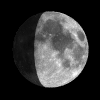Courtesy of EarthSky
A Clear Voice for Science
Visit EarthSky at
www.EarthSky.org

 The waxing gibbous moon and the Pleiades star cluster are found high in the southern sky at early evening. Although the moonlit glare may make it difficult to see this tiny, dipper-shape cluster of starlets tonight, be sure to check out the Pleiades on a dark, moonless night.
The waxing gibbous moon and the Pleiades star cluster are found high in the southern sky at early evening. Although the moonlit glare may make it difficult to see this tiny, dipper-shape cluster of starlets tonight, be sure to check out the Pleiades on a dark, moonless night.
The moon will leave the evening sky during the last week of January 2011, staging the Pleiades in a dark starry sky. Then, you can use Orion’s Belt to find the sky’s most famous star cluster, as we show on tomorrow’s chart.
As evening deepens into late night, the Pleiades follow the moon westward across the sky. They set in tandem beneath the west-northwest horizon in the wee hours after midnight. The farther north you live, the later they set. The farther south you live, the earlier. At mid-northern latitudes in North America, the moon and Pleaides sink below the horizon tomorrow around 3 a.m. local time.
Despite the moonlit glare, you can still use binoculars to gaze at the Pleiades to the east (or left) of the moon tonight. This cluster is also called the Seven Sisters, even though most people can only see six Pleiades’ stars with the unaided eye. Stories about the Lost Pleiad abound in sky lore.
Pleiades star cluster enjoys worldwide renown
Written by Bruce McClure
Astronomy Picture of the Day from NASA/JPL
U.S. Naval Observator Astronomical Information center